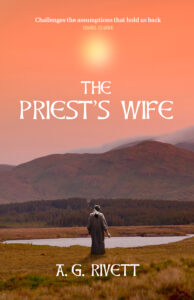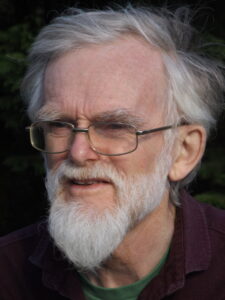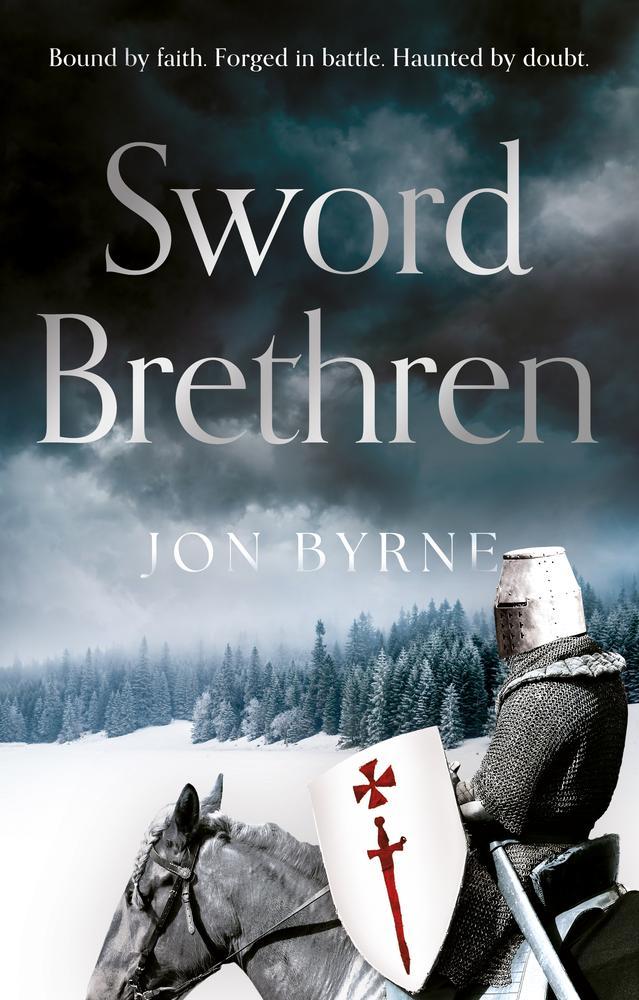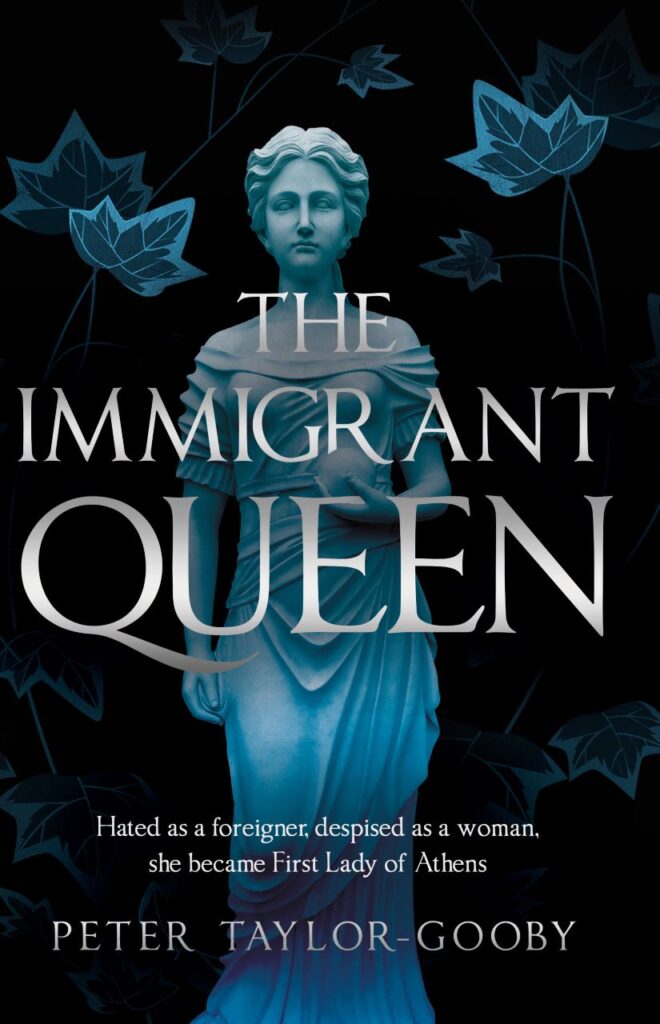A.G. Rivett’s Isle Fincara Trilogy Book 2: The Priest’s Wife
INTERVIEW BY LESLIE S. LOWE
Ceredigion author A.G. Rivett claims to have lived several lives in the course of his one life. Born in London, raised in the Home Counties, he has been a doctor, a priest, and a crofter in the Scottish Highlands. He has lived in rural northern Nigeria and knows what it is like to be ‘a stranger in a strange land’. He and his wife, Gillian Paschkes-Bell, form a team of wordsmiths and writers, exploring issues of various worldviews, of how myth and legend interact with our own lives in diverse ways of describing truth.
How would you describe this book and its themes in a couple of sentences?
A woman’s search for identity and meaning when bereavement takes away her position and role. It’s a deeply spiritual exploration, as a new religious impetus seeks to sweep away her community’s blend of pagan tradition and Christian story.
 What inspired you to start writing historical fiction coming from a medical and faith background and what has been most rewarding about it?
What inspired you to start writing historical fiction coming from a medical and faith background and what has been most rewarding about it?
I began by wondering how a modern engineer might fare in a medieval world. Would he try to show them something? How would they take it? This plunged me into historical narrative, using the devices of the portal fantasy and a parallel world. Although at school I went in for sciences, I also loved reading and writing stories. Historical fiction gives me scope to explore what has been lost and needs to be rediscovered. A potentially fatal flaw in our society is our deepening sense of detachment from the natural world.
How is this latest novel different from The Seaborne or the first book in the Isle Fincara Trilogy?
The Seaborne was the story of John/Dhion. Framed by a prologue and epilogue set in the present, it becomes a vehicle for comparing our technocracies with a pre-industrial society. It also charts a spiritual journey as John becomes Dhion and finds his assumptions challenged in his new environment.
The Priest’s Wife is a more interior book, following Morag’s descent through grief into depression. Her road to healing is mediated by the Guardians, a mysterious group with covert spiritual responsibility for the Island, standing at the opposite pole from the Archpriest. This book is framed by a prologue and epilogue in the voice of the Sidh of the Island, setting the story in the context of the Otherworld.
Why the focus on this topic now? Is there a historical event you found in researching that inspired you to write this story to portray a key message relevant for now?
Augustinian Christianity suppressed the older Celtic Christianity that, according to tradition, travelled via North Africa and the Atlantic seaboard to Ireland and the western fringes of Britain where it blended with Druidic elements. While Roman Christianity taught that God made the Earth ex nihilo, out of nothing, earlier creation myths tell a different story: that the Earth was made from the very substance of the Divine Mystery. The new teaching created an ideological separation between God and nature. It desacralized nature. Because the urge towards power and control expressed through technology explored in The Seaborne is now threatening the balance that has enabled life to flourish, the themes of the first two books of the trilogy are connected.
How does Morag transform within the story? What did that journey mean to you as you wrote it?
Morag is an active and talented woman but her role rests on her husband, the priest. Before Hugh dies, a stranger challenges her about her unknown mother and tells her, ‘you don’t know who you are’. With Hugh gone, the hole in her psyche summons Morag to a quest that leads her, painfully, to a deeper sense of self and releases her ability to respond when summoned. In Morag I found myself working through my own faith journey in a way that challenges both conventional scientific and religious world views.
How do you think the reader will connect with Morag or other characters in the story?
The Herald reviewer, Alistair Mabbott, wrote of Morag: ‘Rivett does an excellent job of putting us inside her head, to the point that we start to feel we know her intimately’. And: ‘I felt I was inside Morag’s head,’ wrote blogger Sharon Rimmelzwaan.
The most tragic figure is Aidan, the Archpriest’s agent, tasked to bring about change. He lacks both skills and conviction and stands for all who are pushed into greater ‘efficiencies’ until they break.
Will the third book in the Isle Fincara trilogy be published next? What are you working on now?
I’m working on the third book of the trilogy, The Shareg (the Island title for the headman of a community). In it, three strands resolve. The Shareg is also framed by a prologue and epilogue set in the present. The story of John/Dhion will be resolved. The political and religious tensions that arise in The Priest’s Wife come to a head, and while the book ends with a victory tempered by sacrifice, this is set against the pathos of knowing there are no long-term guarantees. Finally, an important character who has been playing second fiddle steps forward to fulfill their promise.
How did you balance the research with writing the story? Did you get to do any interesting interviews for your research?
Writing fantasy gives me ‘wiggle room’. However, I’ve sought to keep true to history and have taken pains to be internally consistent. An archaeologistʼs comments on an early draft were immensely helpful.
Both I and Gillian, my wife and editor, have done hours of research. But our experience of the Celtic Céile Dé tradition, which we followed whilst living in Scotland, gave us a direct link to an older worldview that goes beyond research. I have avoided replicating this tradition in my story, but remain informed by it. This lends an authenticity only lived experience can bring.
I had to be guided by others for the birth scene in Chapter 18. I’ve attended many births as a doctor, but drew on the first-hand experience of three mothers to make my writing closer to lived reality.
You are ordained in the Church of England. How has your life experiences been incorporated with or assisted you in your writing?
Seeing the Church from the inside showed me its failings as well as its strengths. My own journey in faith has led me to radically revise my worldview.
My medical background roots me in reality, not only in the functioning of the body but more generally in the physical world. While science is one form of knowledge, and a very effective one, it is not the only way of knowing, nor can it answer every need.
 Every author has their own publishing journey. Tell me about yours.
Every author has their own publishing journey. Tell me about yours.
I found my first publisher as I was about to start looking for agents. Then I learned the hard way about the gap between getting a book into print and getting it into the hands of its readers. A work in process.
What advice would you give to other aspiring historical writers?
Since any novel has at its core a human story, it’s important to get that down first. Then you can research the accidentals that give texture and enhance authenticity.
What is the last great book you read? Why?
Somerset Maugham’s The Razor’s Edge. Maugham is a creature of the French Riviera and that period between the world wars, perhaps a little out of fashion now. I was drawn to the challenge he set himself of writing a main character who defies everyone’s expectations in his quest for the meaning of life, and setting that character among more worldly people. I admired his skill in handling the unusual device of entering the narrative as himself, the novelist Maugham, a character in the book as well as its narrator.
![]()






